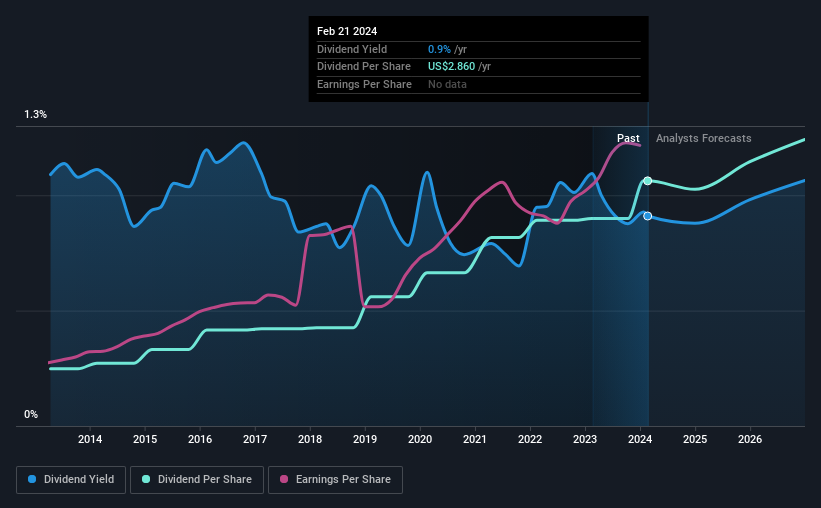Sherwin-Williams (NYSE:SHW) Is Increasing Its Dividend To $0.715
The Sherwin-Williams Company (NYSE:SHW) will increase its dividend from last year's comparable payment on the 8th of March to $0.715. This takes the annual payment to 0.9% of the current stock price, which unfortunately is below what the industry is paying.
View our latest analysis for Sherwin-Williams
Sherwin-Williams' Dividend Is Well Covered By Earnings
The dividend yield is a little bit low, but sustainability of the payments is also an important part of evaluating an income stock. However, prior to this announcement, Sherwin-Williams' dividend was comfortably covered by both cash flow and earnings. This means that most of what the business earns is being used to help it grow.
Over the next year, EPS is forecast to expand by 38.1%. If the dividend continues on this path, the payout ratio could be 22% by next year, which we think can be pretty sustainable going forward.
Sherwin-Williams Has A Solid Track Record
Even over a long history of paying dividends, the company's distributions have been remarkably stable. Since 2014, the annual payment back then was $0.667, compared to the most recent full-year payment of $2.86. This works out to be a compound annual growth rate (CAGR) of approximately 16% a year over that time. Rapidly growing dividends for a long time is a very valuable feature for an income stock.
The Dividend Looks Likely To Grow
Some investors will be chomping at the bit to buy some of the company's stock based on its dividend history. We are encouraged to see that Sherwin-Williams has grown earnings per share at 19% per year over the past five years. A low payout ratio and decent growth suggests that the company is reinvesting well, and it also has plenty of room to increase the dividend over time.
We Really Like Sherwin-Williams' Dividend
Overall, we think this could be an attractive income stock, and it is only getting better by paying a higher dividend this year. Distributions are quite easily covered by earnings, which are also being converted to cash flows. All of these factors considered, we think this has solid potential as a dividend stock.
It's important to note that companies having a consistent dividend policy will generate greater investor confidence than those having an erratic one. Still, investors need to consider a host of other factors, apart from dividend payments, when analysing a company. Taking the debate a bit further, we've identified 1 warning sign for Sherwin-Williams that investors need to be conscious of moving forward. If you are a dividend investor, you might also want to look at our curated list of high yield dividend stocks.
Have feedback on this article? Concerned about the content? Get in touch with us directly. Alternatively, email editorial-team (at) simplywallst.com.
This article by Simply Wall St is general in nature. We provide commentary based on historical data and analyst forecasts only using an unbiased methodology and our articles are not intended to be financial advice. It does not constitute a recommendation to buy or sell any stock, and does not take account of your objectives, or your financial situation. We aim to bring you long-term focused analysis driven by fundamental data. Note that our analysis may not factor in the latest price-sensitive company announcements or qualitative material. Simply Wall St has no position in any stocks mentioned.

